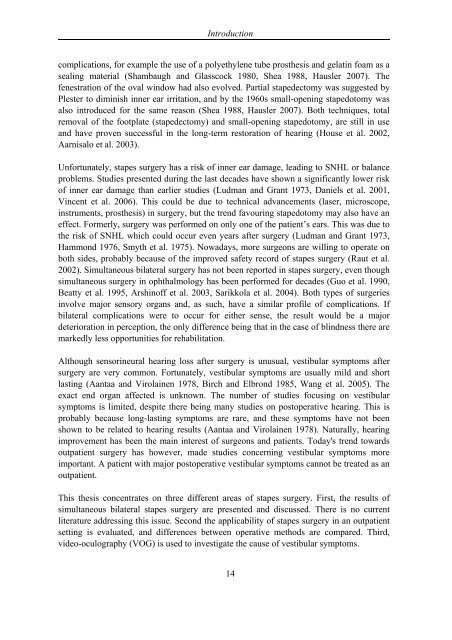Modern surgical treatment of otosclerosis - Helda - Helsinki.fi
Modern surgical treatment of otosclerosis - Helda - Helsinki.fi
Modern surgical treatment of otosclerosis - Helda - Helsinki.fi
You also want an ePaper? Increase the reach of your titles
YUMPU automatically turns print PDFs into web optimized ePapers that Google loves.
Introduction<br />
complications, for example the use <strong>of</strong> a polyethylene tube prosthesis and gelatin foam as a<br />
sealing material (Shambaugh and Glasscock 1980, Shea 1988, Hausler 2007). The<br />
fenestration <strong>of</strong> the oval window had also evolved. Partial stapedectomy was suggested by<br />
Plester to diminish inner ear irritation, and by the 1960s small-opening stapedotomy was<br />
also introduced for the same reason (Shea 1988, Hausler 2007). Both techniques, total<br />
removal <strong>of</strong> the footplate (stapedectomy) and small-opening stapedotomy, are still in use<br />
and have proven successful in the long-term restoration <strong>of</strong> hearing (House et al. 2002,<br />
Aarnisalo et al. 2003).<br />
Unfortunately, stapes surgery has a risk <strong>of</strong> inner ear damage, leading to SNHL or balance<br />
problems. Studies presented during the last decades have shown a signi<strong>fi</strong>cantly lower risk<br />
<strong>of</strong> inner ear damage than earlier studies (Ludman and Grant 1973, Daniels et al. 2001,<br />
Vincent et al. 2006). This could be due to technical advancements (laser, microscope,<br />
instruments, prosthesis) in surgery, but the trend favouring stapedotomy may also have an<br />
effect. Formerly, surgery was performed on only one <strong>of</strong> the patient’s ears. This was due to<br />
the risk <strong>of</strong> SNHL which could occur even years after surgery (Ludman and Grant 1973,<br />
Hammond 1976, Smyth et al. 1975). Nowadays, more surgeons are willing to operate on<br />
both sides, probably because <strong>of</strong> the improved safety record <strong>of</strong> stapes surgery (Raut et al.<br />
2002). Simultaneous bilateral surgery has not been reported in stapes surgery, even though<br />
simultaneous surgery in ophthalmology has been performed for decades (Guo et al. 1990,<br />
Beatty et al. 1995, Arshin<strong>of</strong>f et al. 2003, Sarikkola et al. 2004). Both types <strong>of</strong> surgeries<br />
involve major sensory organs and, as such, have a similar pr<strong>of</strong>ile <strong>of</strong> complications. If<br />
bilateral complications were to occur for either sense, the result would be a major<br />
deterioration in perception, the only difference being that in the case <strong>of</strong> blindness there are<br />
markedly less opportunities for rehabilitation.<br />
Although sensorineural hearing loss after surgery is unusual, vestibular symptoms after<br />
surgery are very common. Fortunately, vestibular symptoms are usually mild and short<br />
lasting (Aantaa and Virolainen 1978, Birch and Elbrond 1985, Wang et al. 2005). The<br />
exact end organ affected is unknown. The number <strong>of</strong> studies focusing on vestibular<br />
symptoms is limited, despite there being many studies on postoperative hearing. This is<br />
probably because long-lasting symptoms are rare, and these symptoms have not been<br />
shown to be related to hearing results (Aantaa and Virolainen 1978). Naturally, hearing<br />
improvement has been the main interest <strong>of</strong> surgeons and patients. Today's trend towards<br />
outpatient surgery has however, made studies concerning vestibular symptoms more<br />
important. A patient with major postoperative vestibular symptoms cannot be treated as an<br />
outpatient.<br />
This thesis concentrates on three different areas <strong>of</strong> stapes surgery. First, the results <strong>of</strong><br />
simultaneous bilateral stapes surgery are presented and discussed. There is no current<br />
literature addressing this issue. Second the applicability <strong>of</strong> stapes surgery in an outpatient<br />
setting is evaluated, and differences between operative methods are compared. Third,<br />
video-oculography (VOG) is used to investigate the cause <strong>of</strong> vestibular symptoms.<br />
14

















